Related Research Articles

The Southeastern Pennsylvania Transportation Authority (SEPTA) is a regional public transportation authority that operates bus, rapid transit, commuter rail, light rail, and electric trolleybus services for nearly four million people in five counties in and around Philadelphia, Pennsylvania. It also manages projects that maintain, replace and expand its infrastructure, facilities and vehicles.
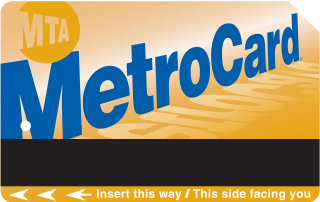
The MetroCard is a magnetic stripe card used for fare payment on transportation in the New York City area. It is a payment method for the New York City Subway, New York City Transit buses and MTA buses. The MetroCard is also accepted by several partner agencies: Nassau Inter-County Express (NICE), the PATH train system, the Roosevelt Island Tramway, AirTrain JFK, and Westchester County's Bee-Line Bus System.

Miami-Dade Transit (MDT) is the primary public transit authority of Miami, Florida and the greater Miami-Dade County area. It is the largest transit system in Florida and the 15th-largest transit system in the United States. As of 2022, the system has 60,734,900 rides per year, or about 251,100 per weekday in the second quarter of 2023. MDT operates the Metrobus with their paratransit STS systems run by LSF. MDT also operates two rail transit systems: Metrorail and Metromover.

SmarTrip is a contactless stored-value smart card payment system managed by the Washington Metropolitan Area Transit Authority (WMATA). The Maryland Transit Administration (MTA) uses a compatible payment system called CharmCard. A reciprocity agreement between the MTA and WMATA allows either card to be used for travel on any of the participating transit systems in the Baltimore-Washington metropolitan area. Unlike traditional paper farecards or bus passes, SmarTrip/CharmCard is designed to be permanent and reloadable; the term "SmarTrip" may refer to both payment systems unless otherwise noted.
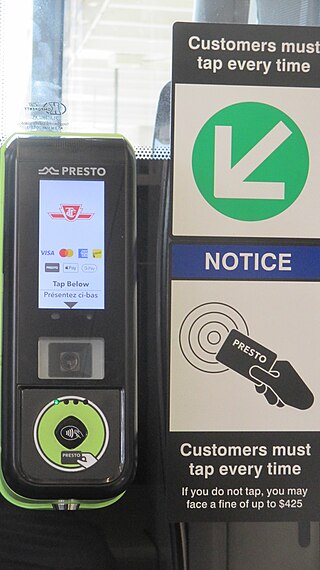
Fares to use the Toronto Transit Commission (TTC) transit system in Toronto, Ontario, Canada, can be paid with various media. The price of fares varies according to age, occupation, income level, and health condition of riders.
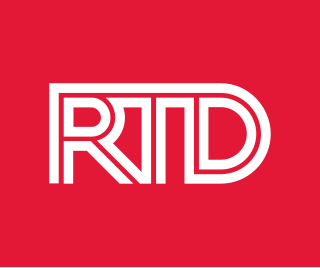
The Regional Transportation District, more commonly referred to as RTD, is the regional agency operating public transit services in eight out of the twelve counties in the Denver-Aurora-Boulder Combined Statistical Area in the U.S. state of Colorado. It operates over a 2,342-square-mile (6,070 km2) area, serving 3.08 million people. RTD was organized in 1969 and is governed by a 15-member, publicly elected Board of Directors. Directors are elected to a four-year term and represent a specific district of about 180,000 constituents.

Winnipeg Transit is the public transit agency, and the bus-service provider, of the City of Winnipeg, Manitoba. Established 140 years ago, it is owned by the city government and currently employs nearly 1,600 people—including approximately 1,100 bus drivers.
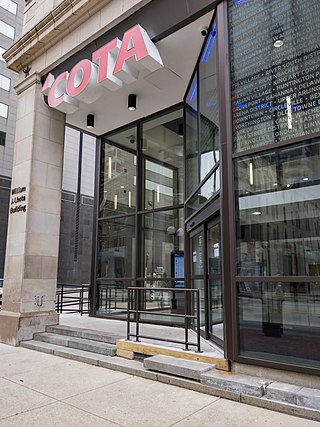
The Central Ohio Transit Authority is a public transit agency serving the Columbus metropolitan area, headquartered in Columbus, Ohio. It operates fixed-route buses, bus rapid transit, microtransit, and paratransit services.

San Joaquin Regional Transit District is a transit district that provides bus service to the city of Stockton, California and the surrounding communities of Lodi, Ripon, Thornton, French Camp, Lathrop, Manteca, and Tracy. In 2022, the system had a ridership of 2,068,800, or about 8,200 per weekday as of the second quarter of 2023.
In North America, a Universal Transit Pass (U-Pass)—also known as a Universal Access Transit Pass—is a program that provides students who are enrolled in participating post-secondary institutions with unlimited access to local transit.

Chittenden County Transportation Authority (CCTA) was the public transit system headquartered in Burlington in Chittenden County, Vermont. CCTA served the communities of Burlington, Essex, South Burlington, Winooski, Shelburne, Williston and Milton. As well as providing regular bus routes to these member municipalities, CCTA also served parts of Colchester and had express routes for commuters travelling between Burlington and Montpelier, Middlebury, and St. Albans.

The ORCA card is a contactless, stored-value smart card system for public transit in the Puget Sound region of Washington, United States. The card is valid on most transit systems in the Seattle metropolitan area, including Sound Transit, local bus agencies, Washington State Ferries, the King County Water Taxi, and Kitsap Fast Ferries. It was launched in 2009 and is managed by the Central Puget Sound Regional Fare Coordination Project, a board composed of local transit agencies.

Free public transport, often called fare-free public transit or zero-fare public transport, is public transport which is fully funded by means other than collecting fares from passengers. It may be funded by national, regional or local government through taxation, or by commercial sponsorship by businesses. Alternatively, the concept of "free-ness" may take other forms, such as no-fare access via a card which may or may not be paid for in its entirety by the user.

The Riverside Transit Agency (RTA) is the main transit agency for western Riverside County, California, United States. RTA provides both local and regional services throughout the region with 39 fixed-routes, 9 CommuterLink routes, and Dial-A-Ride services using a fleet of 339 vehicles. In the cities of Corona, Beaumont and Banning, RTA coordinates regional services with municipal transit systems. In Riverside, RTA coordinates with the city's Riverside Special Services, which provides ADA complementary service to RTA's fixed-route services.
A free travel pass is the privilege of a certain class of passengers to use a public transport service without paying a fare or presenting a ticket. They may need to present an identification card produced by their employer or other sponsoring organization, or by the transit provider.

A transit pass or travel card, often referred to as a bus pass or train pass etc., is a ticket that allows a passenger of the service to take either a certain number of pre-purchased trips or unlimited trips within a fixed period of time.

The Transit Access Pass (TAP) is a contactless smart card used for automated fare collection on most public transport services within Los Angeles County, California. It is administered by the Los Angeles County Metropolitan Transportation Authority (Metro), and the card and fare collection systems are manufactured by Cubic Transportation Systems.
Transport in Shanghai is provided by an extensive network of modes including metro, cycling, bus and taxis, as well as an expansive network of roadways, and airports. Shanghai has invested heavily in public transportation before and after the 2010 World Expo, including the construction of the Hongqiao transportation hub of high-speed rail, air, metro and bus routes.
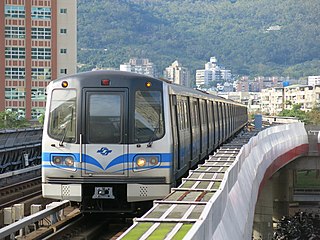
Public transport is a system of transport for passengers by group travel systems available for use by the general public unlike private transport, typically managed on a schedule, operated on established routes, and that charge a posted fee for each trip. There is no rigid definition of which kinds of transport are included, and air travel is often not thought of when discussing public transport—dictionaries use wording like "buses, trains, etc." Examples of public transport include city buses, trolleybuses, trams and passenger trains, rapid transit and ferries. Public transport between cities is dominated by airlines, coaches, and intercity rail. High-speed rail networks are being developed in many parts of the world.
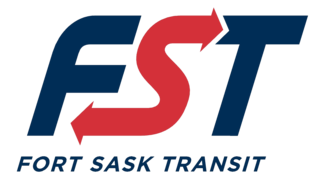
Fort Sask Transit (FST) is a public transit service in the city of Fort Saskatchewan, Alberta. It operates two routes within the city, and a third route is contracted to Edmonton Transit Service (ETS) to connect with its service network.
References
- 1 2 "49 CFR Part 609.23" (PDF). U.S. Gov't Printing Office. Retrieved 23 January 2014.
- ↑ "Appendix A to 49 CFR Part 609" (PDF). U.S. Gov't Printing Office. Retrieved 23 January 2014.
- 1 2 Bell, Judith; et al. "The Transportation Prescription" (PDF). PolicyLink, Prevention Institute, Convergence Partnership. Archived from the original (PDF) on 7 June 2013. Retrieved 29 January 2014.
- ↑ Bailey, Linda. "Aging Americans: Stranded Without Options: Executive Summary" (PDF). The Surface Transportation Policy Project. Archived from the original (PDF) on 19 October 2013. Retrieved 23 January 2014.
- 1 2 "A Profile of Public Transportation Passenger Demographics and Travel Characteristics Reported in On-Board Surveys" (PDF). American Public Transportation Association. Retrieved 29 January 2014.
- ↑ "Transit Ridership Report". American Public Transportation Association. Retrieved 22 January 2014.
- ↑ Koffman, David; et al. "Funding the Public Transportation Needs of an Aging Population" (PDF). American Public Transportation Association. Retrieved 29 January 2014.
- ↑ "Concessionary Travel Scheme Guidance: A Common Approach to Eligibility" (PDF). Welsh Assembly. 20 October 2014.
- ↑ "Using your SuperGold Card on public transport".
- ↑ "Strategy and Policy agenda" (PDF). Waikato Regional Council. 4 Dec 2018.
- ↑ "The Total Mobility Scheme | Ministry of Transport". www.transport.govt.nz. Retrieved 2018-12-04.
- ↑ Sanchez, Thomas W.; et al. "Moving to Equity: Addressing Inequitable Effects of Transportation Policies on Minorities" (PDF). Harvard University and Center for Community Change. Retrieved 29 January 2014.
- ↑ "Universal Access Transit Passes". The Association for the Advancement of Sustainability in Higher Education . Retrieved 29 January 2014.
- ↑ "Banff, AB - Official Website - Low Income Roam Transit Bus Pass". www.banff.ca. Retrieved 2015-10-04.
- ↑ "Low Income Monthly Pass | Calgary Transit". www.calgarytransit.com. Retrieved 2015-10-04.
- ↑ "Edmonton Transit System (ETS) :: City of Edmonton". www.edmonton.ca. Archived from the original on 2015-09-25. Retrieved 2015-10-04.
- ↑ Mertz, Emily. "Less costly transit pass suggested for lower income Edmontonians" . Retrieved 2015-10-04.
- ↑ "City of Grande Prairie, Alberta : Low Income Access Program". www.cityofgp.com. Retrieved 2015-10-04.
- ↑ "AISH Transit Pass - The City of St. Albert". stalbert.ca. Retrieved 2015-10-04.
- ↑ "Everybody Rides | Strathcona County". www.strathcona.ca. Retrieved 2015-10-04.
- ↑ "Discounts for adults". Transport for London. Retrieved 29 January 2014.
- ↑ "Consumer Expenditure Survey, September 2013" (PDF). U.S. Bureau of Labor Statistics. Retrieved 28 January 2014.
- ↑ "Your Driving Costs: 2013 Edition" (PDF). AAA. Retrieved 29 January 2014.
- ↑ Litman, Todd. "Transportation Affordability" (PDF). Victoria Transport Policy Institute. Retrieved 29 January 2014.
- ↑ "Transit Assistance program". Metro Transit. Retrieved 26 April 2019.
- ↑ "SunGO Payment Options". Sun Tran. Retrieved 29 January 2014.
- ↑ "Economy Fares: Low Income". Sun Tran. Retrieved 29 January 2014.
- ↑ Hilkevitch, Jon (25 August 2011). "Confusion, frustration greet new reduced-fare transit cards". Chicago Tribune. Retrieved 23 January 2014.
- 1 2 "Benefit Access Program". Regional Transportation Authority. Retrieved 29 January 2014.
- ↑ "Benefit Access Application - FAQ". Illinois Dept. on Aging. Retrieved 29 January 2014.
- ↑ "Fares and Passes". City of Iowa City. Retrieved 29 January 2014.
- ↑ "Fare Deal Application" (PDF). TheRide. Archived from the original (PDF) on March 6, 2014. Retrieved 29 January 2014.
- ↑ "Reduced Fares". Kitsap Transit. Archived from the original on 18 October 2012. Retrieved 29 January 2014.
- ↑ "Fares and ID Cards". Clark County Public Transit Benefit Area Authority. Retrieved 29 January 2014.
- ↑ "Proposed Fare Change". King County Metro. Retrieved 29 January 2014.
- 1 2 "Final Recommendation to the Madison Common Council" (PDF). Madison Low Income Bus Pass Program Committee. Retrieved 29 January 2014.
- ↑ "Madison Metro Transit expands program offering monthly low-income bus passes". The Daily Cardinal. 15 March 2013. Retrieved 29 January 2014.
- ↑ "Low Income Pass". Metro Transit. Retrieved 29 January 2014.
- ↑ "Progress Toward a Low Income Reduced Fare?". Transit Riders Union. Retrieved 29 January 2014.